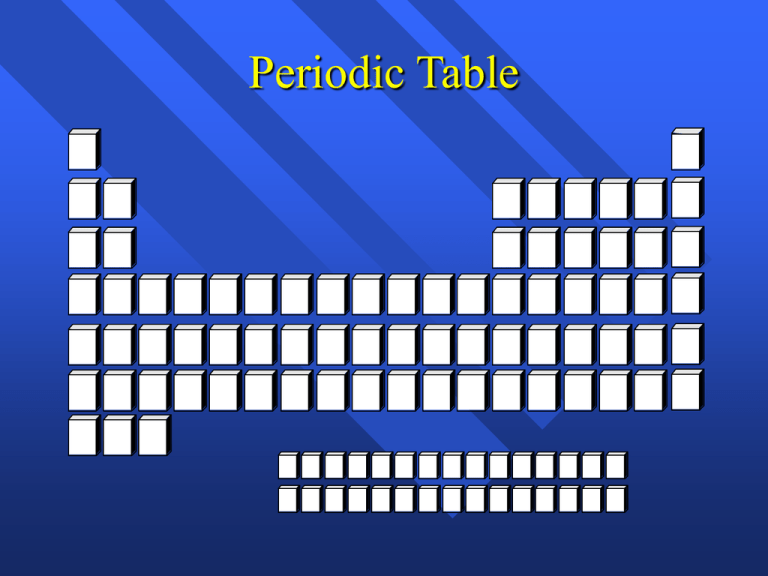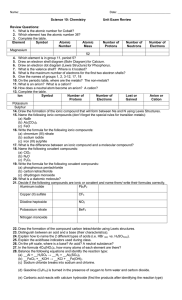Periodic Table
advertisement

Periodic Table Metals Conductors Lose electrons Malleable and ductile Nonmetals Brittle Gain electrons Covalent bonds Semi-metals or Metalloids Alkali Metals Alkaline Earth Metals Halogens Transition metals Noble Gases Inner Transition Metals +1+2 -3 -2 -1 Naming compounds Two types Ionic - metal and non metal or polyatomics. Covalent- we will just learn the rules for 2 non-metals. Ionic compounds If the cation is monoatomic- Name the metal (cation) just write the name. If the cation is polyatomic- name it. If the anion is monoatomic- name it but change the ending to –ide. If the anion is poly atomic- just name it Practice. Covalent compounds Two words, with prefixes. Prefixes tell you how many. mono, di, tri, tetra, penta, hexa, septa, nona, deca First element whole name with the appropriate prefix, except mono. Second element, -ide ending with appropriate prefix. Practice Ionic Compounds Have to know what ions they form off table, polyatomic, or figure it out CaS K2S AlPO4 K2SO4 FeS CoI3 Ionic Compounds Fe2(C2O4) MgO MnO KMnO4 NH4NO3 Hg2Cl2 Cr2O3 Ionic Compounds KClO4 NaClO3 YBrO2 Cr(ClO)6 Naming Covalent Compounds CO2 CO CCl4 N2O4 XeF6 N4O4 P2O10 Ionic Formulas Sodium nitride sodium- Na is always +1 nitride - ide tells you it comes from the table nitride is N-3 Ionic Formulas Sodium nitride sodium- Na is always +1 Nitride - ide tells you it comes from the table nitride is N-3 +1 Na -3 N Ionic Compounds Sodium sulfite calcium iodide Lead (II) oxide Lead (IV) oxide Mercury (I) sulfide Barium chromate Aluminum hydrogen sulfate Cerium (IV) nitrite Covalent compounds The name tells you how to write the formula Sulfur dioxide diflourine monoxide nitrogen trichloride diphosphorus pentoxide Acids Substances that produce H+ ions when dissolved in water. All acids begin with H. Two types of acids: Oxyacids Non-oxyacids Naming acids If the formula has oxygen in it write the name of the anion, but change – ate to -ic acid – ite to -ous acid Watch out for sulfuric and sulfurous H2CrO4 HMnO4 HNO2 Naming acids If the acid doesn’t have oxygen add the prefix hydro change the suffix -ide to -ic acid HCl H2S HCN Formulas for acids Backwards from names. If it has hydro- in the name it has no oxygen Anion ends in -ide No hydro, anion ends in -ate or -ite Write anion and add enough H to balance the charges. Formulas for acids hydrofluoric acid dichromic acid carbonic acid hydrophosphoric acid hypofluorous acid perchloric acid phosphorous acid Hydrates Some salts trap water crystals when they form crystals. These are hydrates. Both the name and the formula needs to indicate how many water molecules are trapped. In the name we add the word hydrate with a prefix that tells us how many water molecules. Hydrates In the formula you put a dot and then write the number of molecules. Calcium chloride dihydrate = CaCl22O Chromium (III) nitrate hexahydrate = Cr(NO3)3 6H2O



